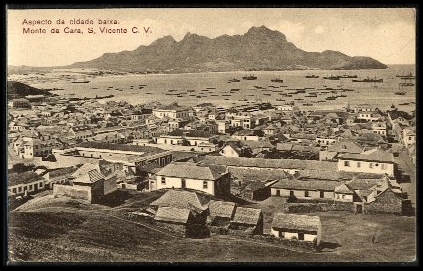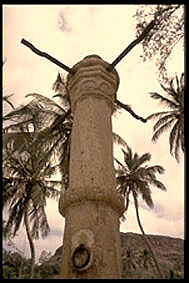|
Conyza Feae
''Conyza feae'' is a species of flowering plant that belongs to the family Asteraceae. The species is endemic to Cape Verde.Oromí, Martín, Zurita & Cabrera, 2005 : Lista preliminar de especies silvestres de Cabo Verde: Hongos, Plantas y Animales Terrestres.' Gobierno de Canarias, Consejería de Medio Ambiente y Ordenación Territorial, p. 41 It is listed as an endangered plant by the IUCN. First described as '' Nidorella feae'', it was placed in the genus ''Conyza'' by Hiram Wild in 1969. The specific name ''feae'' refers to the Italian naturalist Leonardo Fea. Its local name is ''losna-brabo'' or ''losna-bravo''. The plant plays a role in traditional medicine. Distribution and ecology ''Conyza feae'' occurs in the islands of Santo Antão, São Vicente, Santiago Santiago (, ; ), also known as Santiago de Chile (), is the capital and largest city of Chile and one of the largest cities in the Americas. It is located in the country's central valley and is the cent ... [...More Info...] [...Related Items...] OR: [Wikipedia] [Google] [Baidu] |
Augusto Béguinot
Augusto is an Italian, Portuguese, and Spanish given name or surname. Derived from Augustus, meaning in Latin "majestic," "the increaser," or "venerable", it is notable as being the name of the first emperor of Ancient Rome. The Greek translation of the title Augustus was Sebastos, from which the name Sebastian descends. Given name * Augusto Aníbal (1887–1965), Brazilian film actor and singer * Augusto dos Anjos (1884–1914), Brazilian poet and professor * Augusto Arbizo (born 1972), Philippine visual artist * Augusto Antonio Barbera (born 1938), Italian law professor, politician and judge * Augusto Benedico (1909–1992), Mexican actor * Augusto Boal (1931–2009), Brazilian stage director, drama theorist and political activist * Augusto de Campos (born 1931), Brazilian poet * Augusto Fantozzi (1940–2019), Italian lawyer, tax expert, academic, businessman, politician and government minister * Augusto Farfus (born 1983), Brazilian race car driver * Augusto Fernández (b ... [...More Info...] [...Related Items...] OR: [Wikipedia] [Google] [Baidu] |
Hiram Wild
Hiram Wild (15 March 1917 - 28 April 1982) was an English botanist who worked in Southern Rhodesia. Wild studied at Imperial College, University of London. In 1945, he wrote his Ph.D. thesis in which he examined the lettuce pathogen, '' Bremia lactucae''. From 1945, he worked as the government botanist in Southern Rhodesia, and soon became head of the Government Herbarium of Southern Rhodesia. In 1960, Wild started the Herbarium botanical journal 'Kirkia', named for John Kirk (1832–1922), African explorer and companion of David Livingstone. In the ensuing years, he worked as its chief editor. Wild, along with Arthur Wallis Exell, initiated the ''Flora Zambesiaca'' project, a series of monographs on the flora of Africa. In 1965, Wild was appointed professor at Salisbury University College, now known as the University of Zimbabwe. In 1980, due to ill-health, he resigned as professor at Salisbury and moved to Cape Town, South Africa. Personal life Hiram was the son of Hiram Wi ... [...More Info...] [...Related Items...] OR: [Wikipedia] [Google] [Baidu] |
Auguste Chevalier
Auguste Jean Baptiste Chevalier (June 1873, in Domfront – June 1956, in Paris) was a French botanist, taxonomist, and explorer of tropical Africa, especially of French colonial empire in Africa that included Côte d'Ivoire. He also explored and collected plants in South America and tropical Asia. Chevalier was a prolific contributor to the knowledge of African plants, studying forest trees and their woods, grasses, and agricultural plants of the continent. Unlike other botanists who studied the plants of tropical Africa, Chevalier also ranged to the floral regions of the Sahara. In 1896, he obtained his degree in natural sciences and in 1901 his phD from the University of Lille.Prosopo Sociétés savantesJSTOR Global ... [...More Info...] [...Related Items...] OR: [Wikipedia] [Google] [Baidu] |
Asteraceae
Asteraceae () is a large family (biology), family of flowering plants that consists of over 32,000 known species in over 1,900 genera within the Order (biology), order Asterales. The number of species in Asteraceae is rivaled only by the Orchidaceae, and which is the larger family is unclear as the quantity of Extant taxon, extant species in each family is unknown. The Asteraceae were first described in the year 1740 and given the original name Composita, Compositae. The family is commonly known as the aster, Daisy (flower), daisy, composite, or sunflower family. Most species of Asteraceae are herbaceous plants, and may be Annual plant, annual, Biennial plant, biennial, or Perennial plant, perennial, but there are also shrubs, vines, and trees. The family has a widespread distribution, from subpolar to tropical regions, in a wide variety of habitats. Most occur in Hot desert climate, hot desert and cold or hot Semi-arid climate, semi-desert climates, and they are found on ever ... [...More Info...] [...Related Items...] OR: [Wikipedia] [Google] [Baidu] |
Cape Verde
Cape Verde or Cabo Verde, officially the Republic of Cabo Verde, is an island country and archipelagic state of West Africa in the central Atlantic Ocean, consisting of ten volcanic islands with a combined land area of about . These islands lie between west of Cap-Vert, the westernmost point of continental Africa. The List of islands of Cape Verde, Cape Verde islands form part of the Macaronesia ecoregion, along with the Azores, the Canary Islands, Madeira and the Savage Isles. The Cape Verde archipelago was uninhabited until the 15th century, when Portuguese Empire, Portuguese explorers colonized the islands, establishing one of the first Age of Discovery, European settlements in the tropics. Due to its strategic position, Cape Verde became a significant location in the Atlantic slave trade, transatlantic slave trade during the 16th and 17th centuries. The islands experienced economic growth during this period, driven by their role by the rapid emergence of merchants, priva ... [...More Info...] [...Related Items...] OR: [Wikipedia] [Google] [Baidu] |
Nidorella
''Nidorella'' is a genus of African flowering plants in the tribe Astereae within the family Asteraceae Asteraceae () is a large family (biology), family of flowering plants that consists of over 32,000 known species in over 1,900 genera within the Order (biology), order Asterales. The number of species in Asteraceae is rivaled only by the Orchi ..., colloquially known as vleiweed. ; Species References Asteraceae genera Taxonomy articles created by Polbot {{Astereae-stub ... [...More Info...] [...Related Items...] OR: [Wikipedia] [Google] [Baidu] |
Leonardo Fea
Leonardo Fea (Turin 24 July 1852 – Turin 27 April 1903) was an Italian explorer, zoologist, painter, and naturalist. Biography Fea was born in Turin, a son of Paolo Fea, who was professor of painting at Accademia Albertina, and Anna Roda. In 1872 he became an assistant at the Museum of Natural History in Genoa. He made several foreign trips to collect specimens, including visits to Burma (1885–89) and the Cape Verde Islands (1898), the islands in the Gulf of Guinea (São Tomé, Príncipe, Fernando Po, Annobón, 1900–02) and Cameroon and French Congo (1902). He spent four years in Burma, accumulating large collections of insects and birds. He then planned an expedition to Malaysia, but his poor health made it necessary to choose somewhere with a drier climate, hence his visit to the Cape Verdes. He was disappointed by the amount of wildlife he found there, but was still able to collect forty-seven species of birds, eleven of which were new for the islands. His collections ... [...More Info...] [...Related Items...] OR: [Wikipedia] [Google] [Baidu] |
Traditional Medicine
Traditional medicine (also known as indigenous medicine or folk medicine) refers to the knowledge, skills, and practices rooted in the cultural beliefs of various societies, especially Indigenous groups, used for maintaining health and treating illness. In some Asia, Asian and Africa, African countries, up to 80% of people rely on traditional medicine for primary health care. Traditional medicine includes systems like Ayurveda, traditional Chinese medicine, and Unani medicine, Unani. The World Health Organization supports their integration, but warns of potential risks and calls for more research on their safety and effectiveness. The use of medicinal herbs spans over 5,000 years, beginning with ancient civilizations like the Sumer, Sumerians, Ancient Egypt, Egyptians, Indian people, Indians, and Chinese people, Chinese, evolving through Ancient Greece, Greek, Ancient Rome, Roman, Islam, Islamic, and Middle Ages, medieval European traditions, and continuing into Colonial histo ... [...More Info...] [...Related Items...] OR: [Wikipedia] [Google] [Baidu] |
Santo Antão, Cape Verde
Santo Antão (Portuguese language, Portuguese for "Anthony the Great, Saint Anthony") is the northwesternmost island of Cape Verde. At , it is the largest of the Barlavento Islands group, and the second largest island of Cape Verde.Cabo Verde, Statistical Yearbook 2015 Instituto Nacional de Estatística (Cape Verde), Instituto Nacional de Estatística The nearest island is São Vicente, Cape Verde, São Vicente to the southeast, separated by the sea channel Canal de São Vicente. Its population was 38,200 in mid 2019,Instituto Nacional de Estatística, Cabo Verde (web). making it the fourth most populous island of Cape Verde after Santiago, Cape Verde, Santiago, São Vicente and Sal. Its largest city is Porto Novo, Cape Verde, Porto Novo located on the ... [...More Info...] [...Related Items...] OR: [Wikipedia] [Google] [Baidu] |
São Vicente, Cape Verde
São Vicente (Portuguese language, Portuguese for "Vincent of Saragossa, Saint Vincent") is one of the Barlavento Islands, the northern group within the Cape Verde archipelago in the Atlantic Ocean, off the West Africa, West African coast. It is located between the islands of Santo Antão, Cape Verde, Santo Antão and Santa Luzia, Cape Verde, Santa Luzia, with the Canal de São Vicente separating it from Santo Antão. Geography The island is roughly rectangle, rectangular in shape with an area of . From east to west it measures and from north to south .Cabo Verde, Statistical Yearbook 2015 Instituto Nacional de Estatística (Cape Verde), Instituto Nacional de Estatística The island, of volcano, volcanic origin, is fairly flat. The last volcanic activity is considered to have t ... [...More Info...] [...Related Items...] OR: [Wikipedia] [Google] [Baidu] |
Santiago, Cape Verde
Santiago (Portuguese language, Portuguese for “James, son of Zebedee, Saint James”) is the largest island of Cape Verde, its most important agricultural centre and home to half the nation's population. Part of the Sotavento Islands, it lies between the islands of Maio, Cape Verde, Maio ( to the east) and Fogo, Cape Verde, Fogo ( to the west). It was the first of the islands to be settled: the town of Ribeira Grande (now Cidade Velha and a UNESCO World Heritage Site) was founded in 1462. Santiago is home to the nation's capital city of Praia. History The eastern side of the nearby island of Fogo, Cape Verde, Fogo collapsed into the ocean 73,000 years ago, creating a tsunami high which struck Santiago. In 1460, António de Noli became the first to visit the island. Da Noli settled at ''Ribeira Grande'' (now Cidade Velha) with his family members and Portuguese from Algarve and Alentejo in 1462. [...More Info...] [...Related Items...] OR: [Wikipedia] [Google] [Baidu] |
São Nicolau, Cape Verde
São Nicolau (Portuguese language, Portuguese for ''Saint Nicholas'') is one of the Barlavento Islands, Barlavento (Windward) islands of Cape Verde. It is located between the islands of Santa Luzia, Cape Verde, Santa Luzia and Sal, Cape Verde, Sal. Its population is 12,424 (2015),Cabo Verde, Statistical Yearbook 2015 Instituto Nacional de Estatística (Cape Verde), Instituto Nacional de Estatística with an area of . The main towns are Ribeira Brava, Cape Verde, Ribeira Brava and Tarrafal de São Nicolau. History The island was discovered in 1461 or 1462 by Diogo Afonso, together with the islands of São Vicente, Cape Verde, São Vicente and Santo Antão, Cape Verde, Santo Antão.[...More Info...] [...Related Items...] OR: [Wikipedia] [Google] [Baidu] |




